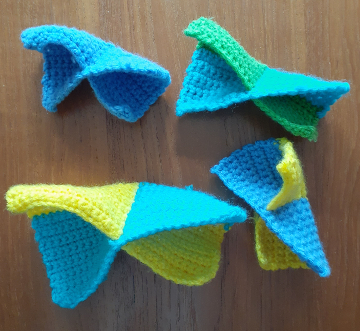Whitney Umbrellas
A Whitney umbrella is a cool surface I wanted to crochet. The umbrella continues to infinity, and there is no way I want to crochet the whole thing. I wanted to make a finite portion of a Whitney umbrella surrounding the most exciting point.

The result is seen in the picture. Technically, I crocheted not Whitney umbrellas but topologically equivalent surfaces. I am most proud of my secret — and painful — method of crocheting the self-intersecting segment. One day I will spill it.
As Wikipedia defines it: the Whitney umbrella is the union of all straight lines that pass through points of a fixed parabola and are perpendicular to a fixed straight line parallel to the parabola’s axis and lies on its perpendicular bisecting plane. If you look at the picture, the fixed straight line is the self-intersection line, which is a continuation of the line segment where the colors are woven through each other. You can find the parabola as the curve formed by the two-colored edge on either side of the umbrella. Oops, I forgot that only three of these umbrellas are made of two colors.
The Whitney umbrella is a ruled surface, meaning that for every point, there is a straight line on the surface that passes through the point. A ruled surface can be visually described as the set of points swept by a moving straight line.
Oh, look, the stitched rows can pretend to be these straight lines. Actually, if I fold these thingies, the stitched rows ARE straight lines. But, when I make the edges into parabolas, the rows stop being straight. In the real Whitney umbrella, if you look along the intersection line, the straight lines are closer to each other than they are along the parabola. But in crochets, the distances between rows have to be fixed. If my crochets are folded, they become rectangles and ruled surfaces. The real Whitney umbrella does not fold into a plane.
The Whitney umbrella is famous for being the only stable singularity of mappings from R2 to R3. I am grateful to Paul Seidel for emailing me the proof. This singularity is so famous it even has two names: pinch point and cuspidal point. Though my crochets are not exactly Whitney umbrellas, they show this singularity. Hooray! I found a secret way to crochet the most famous stable singularity!
Share:
Bruce Fleischer:
Math that can be held and turned in the hands is very satisfying. The intersections look very neat – I assume the secret is not a 4-D crochet hook.
28 February 2023, 6:36 pmIs it possible to crochet double-layer fabric? The umbrella looks like a 2-sided surface with each surface being on the inside of the parabola on one side of the singularity, and on the outside on the other.
I was inspired to realize similar (truncated) umbrellas via 3D printing. Results are on the linked thingiverse page (should work on/after Mar 1).
On the printer now: two truncated umbrellas, joined with a twist where the lines cross at right angles. This surface looks like it has only side.
Bruce Fleischer:
My thingiverse thing is now viewable, https://www.thingiverse.com/thing:5883559
Is there something special about the parabola? In the wikipedia paramterization, wouldn’t other functions, such as z=v^4, also give a ruled surface (since x = vy)? Is the parabola necessary for the stability of the singularity?
1 March 2023, 2:18 pmtanyakh:
Bruce, cool 3d printing on your website.
To answer your question, the parabola is not necessary for singularity. Whitney umbrella, that uses a parabola in its definition, is the simplest and the most famous surface with this singularity.
2 March 2023, 11:16 amTanya Khovanova's Math Blog » Blog Archive » Klein Bottles without Holes, or How to Crochet Through:
[…] I crocheted Whitney Umbrellas, I got excited that I figured out how to crochet through an existing layer of fabric. I decided to […]
9 July 2023, 7:44 pm